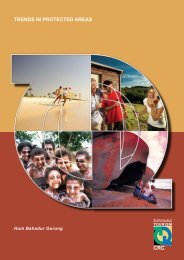icolls - Sustainable Tourism CRC
icolls - Sustainable Tourism CRC
icolls - Sustainable Tourism CRC
Create successful ePaper yourself
Turn your PDF publications into a flip-book with our unique Google optimized e-Paper software.
ECOLOGY, THREATS AND MANAGEMENT OPTIONS FOR SMALL ESTUARIES AND ICOLLS<br />
the estuary as well as the main channel. Combinations of the biological and physical data in the form of the<br />
elevation model will allow the development of a better understanding of the spatial dynamics of the biota using<br />
the estuary. Of particular interest is the potential of a mass migration of fish from the main channel out onto the<br />
shallow flooded land following a severe loss of oxygen from the water column of the main channel, which is a<br />
feature of the Surrey Estuary. Temporal trends in the fish community are also to be investigated which will focus<br />
on the distribution of fish throughout the estuary as well as the migration of fish between the estuary and ocean<br />
during times when the mouth is open.<br />
Title of paper: The response of macrophytes to changes in physico-chemical conditions in temporarily<br />
open/closed estuaries<br />
Author: Janine Adams<br />
Author's email: btajba@upe.ac.za<br />
Abstract: Increased freshwater abstraction from estuaries can have a major influence on the physico-chemical<br />
characteristics of temporarily open-closed systems. A reduction in freshwater inflow increases the frequency and<br />
duration of mouth closure. Changes in salinity and increased water levels then cause changes in the macrophyte<br />
communities. South Africa has approximately 186 temporarily open / closed estuaries. These estuaries are<br />
characterised by lower species richness than permanently open estuaries. The impacts of freshwater abstraction<br />
are often greatest in the smaller estuaries. For example the Klipdrif (oos) and Slang estuaries have changed from<br />
intermittently to almost permanently closed. Reeds have expanded due to sedimentation and dune encroachment.<br />
Floods that are important in re-setting the estuary and removing the macrophytes from the main water channel no<br />
longer occur. In other estuaries management interventions have mitigated the impacts of freshwater abstraction.<br />
For example in the Great Brak Estuary, South Africa, a mouth management plan and water releases from the<br />
Wolwedans dam have ensured that the mouth has remained open at important times i.e. spring / summer. Long<br />
term monitoring has shown that the salt marsh is in a healthy condition as a result of this. Low water levels<br />
during the open mouth condition ensure the germination of seeds and growth of seedlings. Both intertidal and<br />
supratidal species are found and the salt marshes show distinct zonation brought about by tidal inundation. When<br />
freshwater releases weren’t made, a year of prolonged mouth closure (1 year), high water level and flooding of<br />
the marsh reduced the cover of supratidal (Chenolea diffusa and Sporobolus virginicus) and intertidal salt marsh<br />
species (Triglochin spp. and Cotula coronopifolia). Besides salinity and water level fluctuations other important<br />
factors controlling macrophytes in temporarily open / closed estuaries are light and nutrient input. The lack of<br />
submerged macrophytes in KwaZulu-Natal estuaries on the east coast of South Africa has been attributed to an<br />
increase in catchment and bank erosion, sedimentation and lack of available light. In some estuaries nutrient<br />
input coupled with prolonged mouth closure has resulted in excessive macroalgal growth. Although temporarily<br />
open closed estuaries are dynamic, resilient systems, degradation of macrophytes and species losses can occur in<br />
response to changes in freshwater inflow.<br />
Title of paper: The effect of catchment runoff on the ecology and chemistry of Myall Lakes<br />
Author: Joanne Wilson and Matthew Dasey<br />
Author's email: joanne.wilson@dipnr.nsw.gov.au<br />
Abstract: The Myall Lakes system is made up of four interconnected brackish lakes covering over 100km2 and<br />
is the central feature of Myall Lakes National Park, 300km north of Sydney. It has a limited connection to the<br />
ocean via the Lower Myall River. Myall Lakes was considered pristine until harmful algal blooms (Anabaena<br />
and Microcystis) were reported in 1999 indicating the potentially eutrophic status of the lakes. Most nutrients are<br />
sourced from catchment runoff delivered during rain events. The aim of this study was to examine short-term<br />
changes in the lakes after a rain event. Nine sites throughout Myall Lakes were sampled on 8 occasions over a<br />
34-day period after a small rain event in December 2002. Measures included water quality profiles, inorganic,<br />
organic and total nutrients (nitrogen, phosphorus and silica), turbidity, chlorophyll a, and phytoplankton counts.<br />
The results showed a 3-20 fold increase in concentrations of NOx, NH4+, FRP and TP in fresh, surface water<br />
inflows from the Upper Myall River, which has agricultural activities in its catchment. In contrast, runoff from<br />
Boolambayte Creek, which has a largely undisturbed catchment, showed only slightly elevated levels of NOx<br />
and TP. Elevated nutrient levels did not persist for more than 2 – 4 days, indicating rapid dilution, uptake and<br />
recycling within the lake. Stratification was an important feature of the water column at some sites after the<br />
freshwater inflow and was associated with high ammonia levels in bottom waters. Counts of a number of<br />
phytoplankton species increased at some sites 4-6 days after the rain event. This study has demonstrated the link<br />
between catchment runoff and the nutrient status of the lake. This information will be used to develop effective<br />
nutrient reduction programs in the catchment and cost effective sampling programs that accurately reflect the<br />
types of inputs and nutrient status of coastal water bodies.<br />
55











